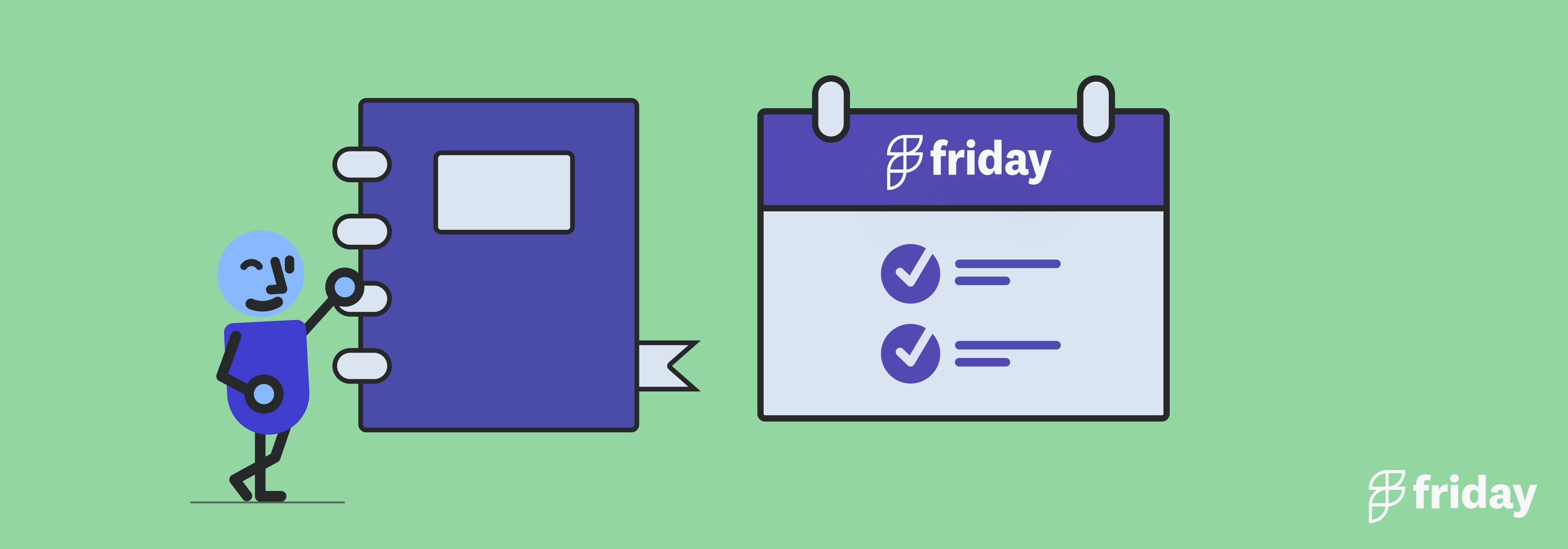10 Tips for Creating a Great Daily Schedule for Work

Aside from the fact the word schedule comes from old French, it’s not so scary. Manufacturers, doctors, hairdressers, buses, you name it – these handy timesheets are all around us, ensuring everything gets done with a minute to spare.
On a personal level, a schedule allows you to set aside time for specific tasks. It helps you to become more organized and prioritize the tasks that are most important. It supposedly raises cognitive performance, as recorded in a 2016 study that found, of over 300 participants, those with busier schedules performed better in word and number puzzles, among other tests.
They’re so influential, in fact, that many find that they can't get anything done at all without an old, trusty calendar. If that’s you, you’ve probably been searching for some scheduling secrets –conveniently put into a list of 10, we should say – to better keep track of priority tasks and stick to due dates. Well then, look no further!
1. Schedule the Week, Plan the Day
In our modern surroundings, we constantly witness how quickly information, trends or opinions can go out of date. Our brains are always taking in updates to make sure we’re working with the most current understanding. Schedules are no different.
Most of us will surely craft one long to-do list before we worry about allocating time. Once you have a mighty list of tasks, you should absolutely plant them nicely across the week. You may do so by prioritizing their importance and urgency, as in the Eisenhower matrix, so you know exactly what to tackle first.
However, a weekly schedule can quickly fall apart unless you reaffirm to yourself what needs doing. You should spend some time translating your scheduled jobs into a daily routine. As you’ll be receiving new information throughout your week, factoring in these updates keeps the schedule relevant and effective.
You speed up your work rate by spending time in the morning, or evening prior, drafting up a plan. They keep you focused and boost memory, providing you with a clear vision of the day, as supported by a 2011 entry in The American Journal of Psychology that found “a more active interaction with information, as with note taking... facilitates deeper comprehension [and] memory improves.”
2. Use Time Blocking for Better Schedules
Of course, there must be some system for determining how much time to spend on each task, lest you burn away 3 hours stressing on the perfect font for a quarterly report. Time blocking is a method through which you sit down and fully commit to one thing (single-tasking) in order to minimize distraction and actually complete tasks in the time you’ve allotted to them, or blocks of time.
This crucial step between plan and action helps you to break down each task into a realistic amount of time. For example, if you want to stay current on the literature of a topic, you can block out an hour on your schedule two days a week. Without such, you’ll likely while away the time.
Cast your mind back to your schooldays, particularly the schedule you had, where each subject was given its own period, and you’ll find time blocking is not too dissimilar. In any given work day, use your daily plan to correspond tasks with specific times. Remember, you can (and should!) always adjust your schedule to accommodate new priorities or time changes as the week goes on.
If you’re a little lousy at time-keeping, use the pomodoro technique to make time blocking that much easier.
3. Generate New Task Ideas for your Schedule
You should always be looking for new ideas that are beneficial to productivity, whether they’re 5 minute preparation tasks that put you into the right frame of mind, or review activities that instill a sense of accomplishment and set you up for success tomorrow.
You may have fallen into the trap of thinking more is always best and packed your schedule with 100% work items; to the untrained eye, this is a brilliant idea, but you’ll soon find out how unmanageable that is. All work and no play makes Jack a dull boy, as the saying goes.
Try to consider new task ideas that either stimulate your underworked brain areas or give you clearer insight into your productivity habits. Don’t simply say you’ll try them if you’ve got time, but schedule them in! Things such as a creative brainstorm, a midday assessment or a light-concentration activity, even if it is a quick puzzle to sharpen the brain, can minimize mental fatigue by keeping things interesting and varied.
4. The First-Hour Rule and your Proactive-Reactive Split
“The first-hour rule is that the first hour of the workday is usually the quietest hour in an office,” explains time-management specialist Tom Limoncelli, in Time Management for System Administrators. He then declares: “I bet you spend it catching up with email.” Well, if you choose to do so, you’re actually starting the day in a reactive state rather than a proactive state.
Proactive tasks are those which you have predefined, they’re firmly on the schedule, whereas reactive tasks occur as a response to a circumstance or event, often unforeseen. Apart from that brisk corridor hello you gave Jane from accounting, you’ve trapped yourself in a chain of reactive tasks that would love nothing more than to eat all of your time, absolutely toxic for productivity.
“Instead of letting these tasks consume your first hour,” continues Limoncelli, “why not check your email for subject lines that look important, read those, and then shut off your email reader. Now spend that first hour on a project. You won’t have nearly as many interruptions, and the email will be there when you’re done.”
Even if checking emails is pertinent to your immediate jobs, try not to make it the first thing you do; it’s far more reactive than, say, making the daily checklist, a brief team meeting, or simply getting stuck in with one of your planned tasks.
5. Consider your Energy Levels Throughout the Day
While we’ve talked about the first-hour rule, it’s also pretty important to create a schedule that will factor in energy levels and most productive times throughout the day. Not long after your morning coffee, your brain should be fully fired-up, so you might benefit from planning brain-heavy tasks earlier in the day. Oppositely, if you are a bit of a slow-burner, you may want to schedule low-focus tasks in the early hours before tackling the bigger jobs later on.
In 2020, an IZA Research Institute study observed that, “the productivity profile of students during the day has an inverse U-shape relationship, where peak performance occurs around lunchtime (1.30pm)” and that their “results suggest that the time-of-day is a crucial determinant for the performance of students.”
This is no coincidence; it has everything to do with our cognitive rhythms, the ebbs and flows in energy as we wade through the day. Depending on your individual make-up, this period of peak productivity can vary, so you’ll need to experiment a little. Once you’ve found your optimal window of production, create a schedule that complements it, placing the most challenging or key tasks at times when you’ll be experiencing your highest energy levels (superior focus) and low-energy jobs like meetings and emails for when you experience the inevitable lull in concentration.
6. Keep Your Tasks/Commitments in One Central Place
Unless you’re preparing for some extravagant Easter hunt, it’s best if you keep all of your eggs together. The same goes for your various task-lists, calendars and communication tools – think Google, Microsoft, Trello, Asana and Slack. If you’ve got information coming in from a multitude of sources, it becomes exceptionally irritating to maintain a handle on it, thus keeping all of your commitments in one place is important.
A clever solution such as this not only makes it simpler to keep track of your tasks and responsibilities, but also to more effectively stick to the objectives that you have set for the day, eliminating the need to be continually zigzagging between apps or devices.
7. The Optimism Bias and Realistic Scheduling
You can do wonderful things, of that we’re sure! However, you may need a little longer than you think. Across the board, we’re prone to a little optimism bias, the tendency for us to anticipate more positive results than reality, colloquially known as wishful thinking. In scheduling terms, this usually manifests as an underestimate of the time needed to complete a task, otherwise known as the planning fallacy.
Be mindful of this mental disposition by scheduling a realistic, achievable quantity of work that you can actually accomplish in one day. Firstly consider what exactly your work expectations are based on, because if it’s the relentless grumbling of a boss trying to get their bonus, or some generalized article that is pressuring you to do a thousand things per day, it may not be the most applicable benchmark for you.
Regardless of whether you end up achieving everything you wanted to, sticking to your schedule will yield greater results, as any attention to organization breeds productivity. Take into account the nature of your tasks and the drain they’ll have on your energy levels, too.
Knowledge is power: be aware of this tendency to create overly ambitious agendas that will leave you feeling disappointed, no matter how productive you are. If one of your tasks is taking longer than you had planned, adjust the formula to build a more accurate schedule tomorrow.
Note: For a few more pointers on realistic scheduling, check out our discussion on time-management apps.
8. Task Batching to Optimize Efficiency
An often undervalued variable in a good daily schedule is the type of tasks that you’ve planned, and how they correspond with each other. Through a process known as “context-switching”, the process of the mind literally shifting gears between different styles of tasks, for instance emails, writing, communicating, researching, etc.
Many of these tasks require a unique headspace, and there is no immediate issue in that. The problem arises, however, when we repeatedly change during the day, each time reducing our efficiency, both in terms of work produced and energy used; hence the potential benefits of task batching, the process of bunching similar tasks together to minimize these cognitive inefficiencies.
By doing all of your email responsibilities in one go, you eliminate the continual checking of emails throughout the day if you hadn’t scheduled them together. Correspondingly, doing a solid, uninterrupted hour of research is far more valuable than three 20 minute sessions.
9. Reflect on your Daily Progress
While a schedule is predominantly meant to ensure you get everything done, it also acts as an observable record of your success, becoming an opportunity to congratulate yourself, and an evidence base for enacting positive changes in future scheduling.
Whether you’re crossing off a physical task-list or keeping up a spreadsheet that you update throughout the day, you can reassure yourself with these steady glances at the progress you’re making. You can create a list of introspective questions, or take advantages of an existing example, such as the Gibbs Reflective Cycle.
Keep track of your accomplishments to see what you completed and what you didn't complete. This will allow you to adjust your schedule if you fall behind, or to look back on the week to see how productive you were.
Journaling can offer comprehensive reflection, especially bullet journals, as different sections, such as the weekly spread or mood tracker, can correspond with each other to give you a clearer picture of your productivity. Of course, doing some contemplative writing every day will enhance memory and creativity, too!
Note: To get started bullet journaling, learn how to rapid log from our guide.
10. Schedule Life, Not Just Work
Lastly, remember that while these scheduling tips are in regard to the workday, many of them stay relevant in other aspects of your life, such as family and personal time. Once you’re in command of your time, you will be pleasantly surprised to find that you’ve actually got quite a lot of it at your disposal.
If you want to spend more time with your family, you are free to add that time to your schedule, through specific activities such as going out to dinner or watching a movie together. Similarly, if you’re desperate to learn guitar, treat that endeavor as a work task, scheduling it seriously and committing to the time allocated.
Consistently practicing effective scheduling techniques across your entire life will actually accelerate the transition from tattered to-do list to awesome agenda, effectively conditioning you to look at all challenges with the same desire for maximum organization and output.
A planner is a godsend amidst the chaos of a hectic week. You can compile task-lists in separate places, such as a diary for personal ambitions and a work journal for professional goals, but they should all come under one unified schedule.
Conclusion: Try To Repeat The Process for a Great Daily Schedule
Obviously, planning your life is not a straightforward timetable, but rather an attempt to bind your work to time. If you don’t already have some form of schedule, it will be hard to make one and stick to it, but if you can get to a point where it becomes natural, a kind of automation, you’ll see a huge jump in productivity.
In order to do so, make scheduling a do-or-die habit, repeating the process every week, religiously. Get accustomed to thinking of your tasks in terms of their time blocks so that scheduling becomes a second language. In a surprisingly short amount of time, you’ll have things running like clockwork!


